Temperature FIAT FIORINO 2019 Owner handbook (in English)
[x] Cancel search | Manufacturer: FIAT, Model Year: 2019, Model line: FIORINO, Model: FIAT FIORINO 2019Pages: 220, PDF Size: 6.22 MB
Page 45 of 220

Versions with multifunction display
Warning lights
andare available on diesel versions only.
A. Speedometer – B. Fuel level gauge with reserve warning light – C. Engine coolant temperature indicator with overheating warning light – D. Rev
counter – E. Multifunction display
75F0T0810
43
Page 47 of 220
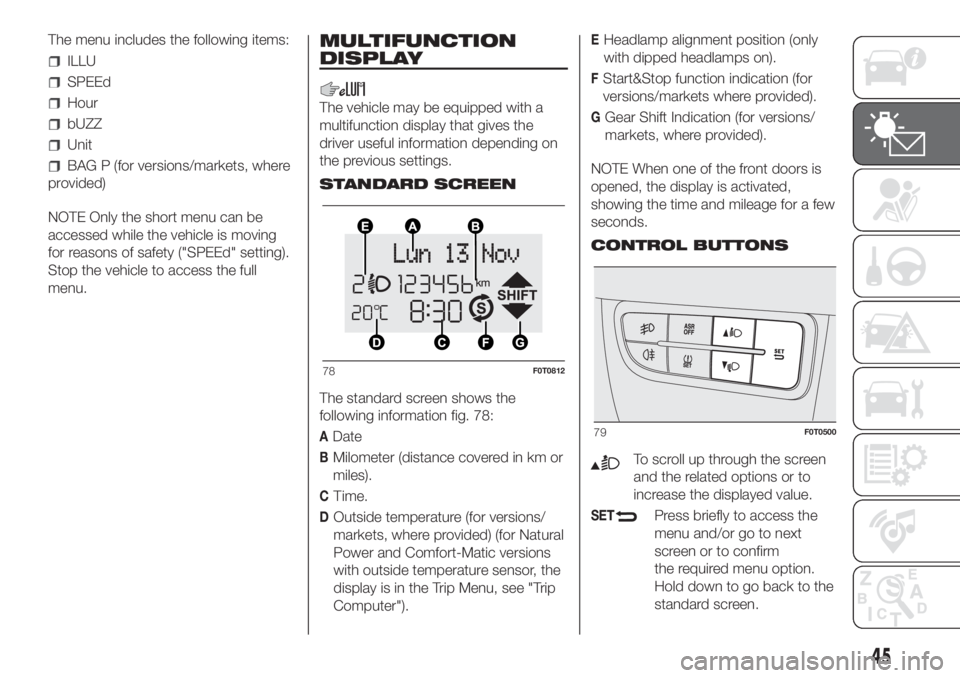
The menu includes the following items:
ILLU
SPEEd
Hour
bUZZ
Unit
BAG P (for versions/markets, where
provided)
NOTE Only the short menu can be
accessed while the vehicle is moving
for reasons of safety ("SPEEd" setting).
Stop the vehicle to access the full
menu.
MULTIFUNCTION
DISPLAY
The vehicle may be equipped with a
multifunction display that gives the
driver useful information depending on
the previous settings.
STANDARD SCREEN
The standard screen shows the
following information fig. 78:
ADate
BMilometer (distance covered in km or
miles).
CTime.
DOutside temperature (for versions/
markets, where provided) (for Natural
Power and Comfort-Matic versions
with outside temperature sensor, the
display is in the Trip Menu, see "Trip
Computer").
EHeadlamp alignment position (only
with dipped headlamps on).
FStart&Stop function indication (for
versions/markets where provided).
GGear Shift Indication (for versions/
markets, where provided).
NOTE When one of the front doors is
opened, the display is activated,
showing the time and mileage for a few
seconds.
CONTROL BUTTONS
To scroll up through the screen
and the related options or to
increase the displayed value.
SETPress briefly to access the
menu and/or go to next
screen or to confirm
the required menu option.
Hold down to go back to the
standard screen.
78F0T0812
79F0T0500
45
Page 48 of 220
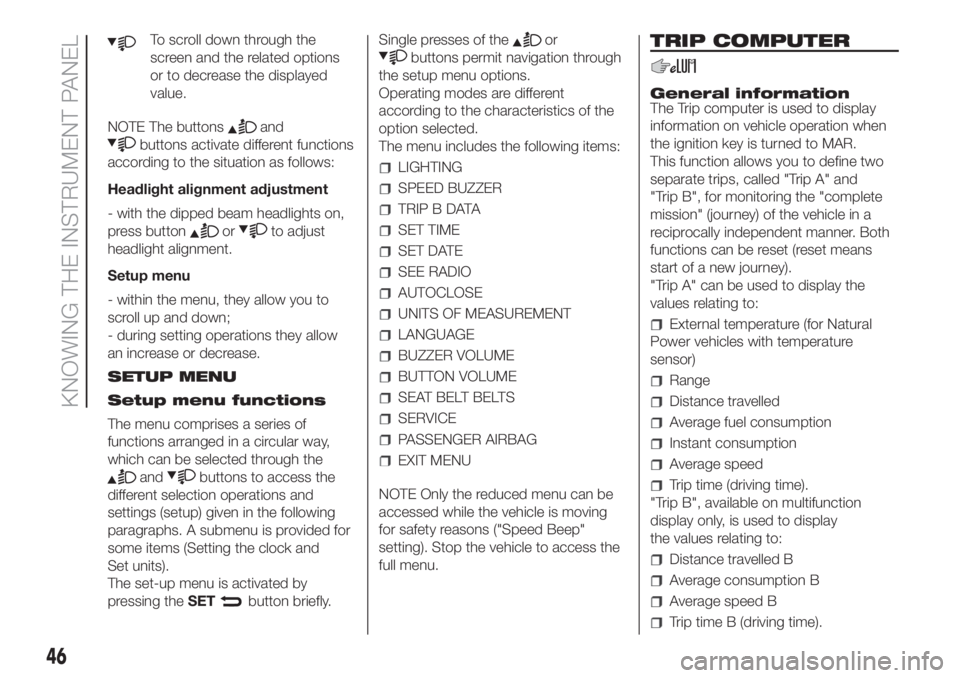
To scroll down through the
screen and the related options
or to decrease the displayed
value.
NOTE The buttons
and
buttons activate different functions
according to the situation as follows:
Headlight alignment adjustment
- with the dipped beam headlights on,
press button
orto adjust
headlight alignment.
Setup menu
- within the menu, they allow you to
scroll up and down;
- during setting operations they allow
an increase or decrease.
SETUP MENU
Setup menu functions
The menu comprises a series of
functions arranged in a circular way,
which can be selected through the
andbuttons to access the
different selection operations and
settings (setup) given in the following
paragraphs. A submenu is provided for
some items (Setting the clock and
Set units).
The set-up menu is activated by
pressing theSET
button briefly.Single presses of the
or
buttons permit navigation through
the setup menu options.
Operating modes are different
according to the characteristics of the
option selected.
The menu includes the following items:
LIGHTING
SPEED BUZZER
TRIP B DATA
SET TIME
SET DATE
SEE RADIO
AUTOCLOSE
UNITS OF MEASUREMENT
LANGUAGE
BUZZER VOLUME
BUTTON VOLUME
SEAT BELT BELTS
SERVICE
PASSENGER AIRBAG
EXIT MENU
NOTE Only the reduced menu can be
accessed while the vehicle is moving
for safety reasons ("Speed Beep"
setting). Stop the vehicle to access the
full menu.
TRIP COMPUTER
General information
The Trip computer is used to display
information on vehicle operation when
the ignition key is turned to MAR.
This function allows you to define two
separate trips, called "Trip A" and
"Trip B", for monitoring the "complete
mission" (journey) of the vehicle in a
reciprocally independent manner. Both
functions can be reset (reset means
start of a new journey).
"Trip A" can be used to display the
values relating to:
External temperature (for Natural
Power vehicles with temperature
sensor)
Range
Distance travelled
Average fuel consumption
Instant consumption
Average speed
Trip time (driving time).
"Trip B", available on multifunction
display only, is used to display
the values relating to:
Distance travelled B
Average consumption B
Average speed B
Trip time B (driving time).
46
KNOWING THE INSTRUMENT PANEL
Page 53 of 220
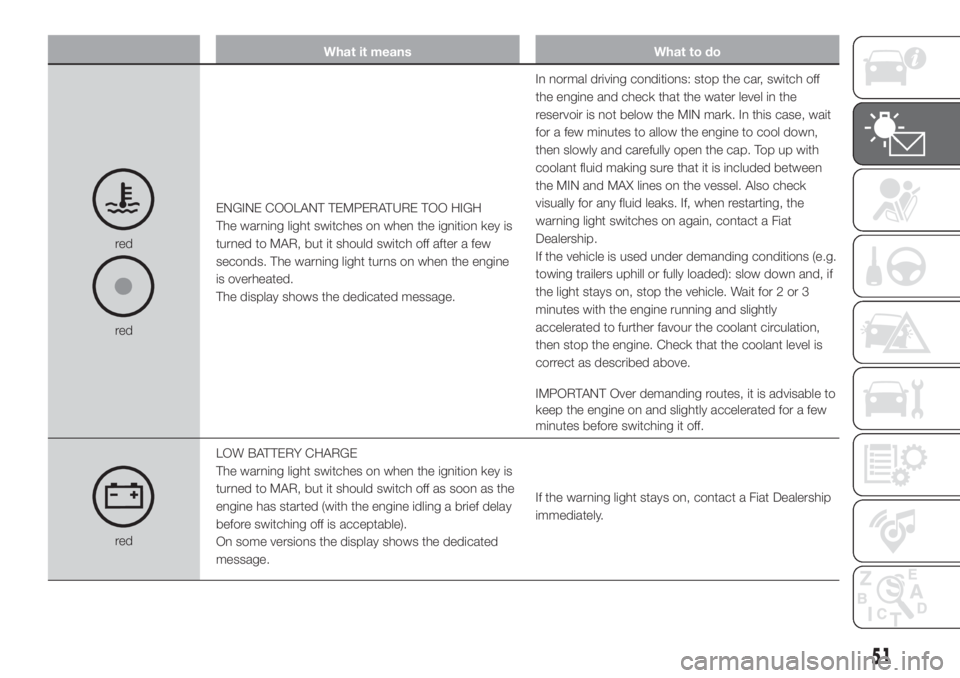
What it means What to do
red
redENGINE COOLANT TEMPERATURE TOO HIGH
The warning light switches on when the ignition key is
turned to MAR, but it should switch off after a few
seconds. The warning light turns on when the engine
is overheated.
The display shows the dedicated message.In normal driving conditions: stop the car, switch off
the engine and check that the water level in the
reservoir is not below the MIN mark. In this case, wait
for a few minutes to allow the engine to cool down,
then slowly and carefully open the cap. Top up with
coolant fluid making sure that it is included between
the MIN and MAX lines on the vessel. Also check
visually for any fluid leaks. If, when restarting, the
warning light switches on again, contact a Fiat
Dealership.
If the vehicle is used under demanding conditions (e.g.
towing trailers uphill or fully loaded): slow down and, if
the light stays on, stop the vehicle. Wait for 2 or 3
minutes with the engine running and slightly
accelerated to further favour the coolant circulation,
then stop the engine. Check that the coolant level is
correct as described above.
IMPORTANT Over demanding routes, it is advisable to
keep the engine on and slightly accelerated for a few
minutes before switching it off.
redLOW BATTERY CHARGE
The warning light switches on when the ignition key is
turned to MAR, but it should switch off as soon as the
engine has started (with the engine idling a brief delay
before switching off is acceptable).
On some versions the display shows the dedicated
message.If the warning light stays on, contact a Fiat Dealership
immediately.
51
Page 54 of 220

What it means What to do
redINSUFFICIENT ENGINE OIL PRESSURE/ENGINE OIL
DETERIORATED
When the key is turned to MAR the warning light
comes on, but should go out as soon as the engine is
started.
Steady light: Low engine oil pressure
The warning light comes on fixed, together with a
message on the display (for versions/markets, where
provided) when the system detects insufficient engine
oil pressure.
37)
On blinking: Engine oil deteriorated
(for Multijet versions only)
The warning light starts to flash together with a
message on the display (for versions/markets, where
provided) when the system detects that the engine oil
has deteriorated.
If the warning light flashes, this does not mean that the
vehicle is faulty, but simply informs the driver that it is
now necessary to change the engine oil as a result of
regular vehicle use. If the oil is not changed, warning
light
will also come on and engine operation is
limited to 3000 rpm when a second threshold is
reached.
If the oil is still not changed, when a third deterioration
threshold is reached, the engine is limited to 1500 rpm
to avoid damage.Contact a Fiat Dealership as soon as possible.
9)
Remember that the deterioration of the engine oil is
accelerated by:
– mainly town use of the vehicle which makes the DPF
regeneration process more frequent
– use of the vehicle for short trips, preventing the
engine from reaching operating temperature
– repeated interruption of the regeneration process,
signalled by the DPF warning light coming on.
52
KNOWING THE INSTRUMENT PANEL
Page 60 of 220

What it means What to do
amberPLUG PREHEATING (Multijet versions) - PLUG
PREHEATING FAULT (Multijet versions)
Glow plugs
(Multijet versions)
This warning light switches on when the key is turned
to MAR. It will switch off as soon as the glow plugs
have reached a preset temperature.
IMPORTANT At high ambient temperatures the
warning light may stay on for an extremely short time.Start the engine as soon as the warning light switches
off.
Glow plug preheating failure
(Multijet versions)
The warning light flashes if there is a fault in the
preheating system.
On some versions the display shows the dedicated
message.Contact a Fiat Dealership as soon as possible.
amberWATER IN DIESEL FILTER (Multijet versions)
The warning light switches on when the ignition key is
turned to MAR, but it should switch off after a few
seconds.
The
warning light switches to indicate presence of
water in the diesel filter.
On some versions the display shows the dedicated
message.11)
amberLow diesel emissions additive (UREA) level warning
(for versions/markets, where provided)
The Diesel Emissions Additive (UREA) low level
warning light
lights if the vehicle has a low UREA
level.
58
KNOWING THE INSTRUMENT PANEL
Page 112 of 220
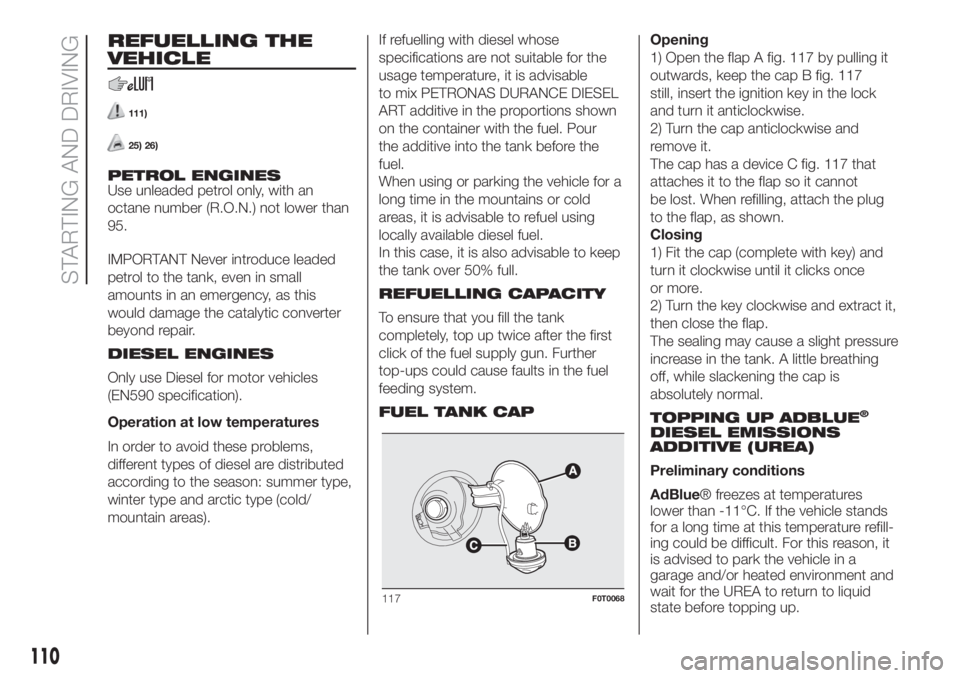
REFUELLING THE
VEHICLE
111)
25) 26)
PETROL ENGINES
Use unleaded petrol only, with an
octane number (R.O.N.) not lower than
95.
IMPORTANT Never introduce leaded
petrol to the tank, even in small
amounts in an emergency, as this
would damage the catalytic converter
beyond repair.
DIESEL ENGINES
Only use Diesel for motor vehicles
(EN590 specification).
Operation at low temperatures
In order to avoid these problems,
different types of diesel are distributed
according to the season: summer type,
winter type and arctic type (cold/
mountain areas).If refuelling with diesel whose
specifications are not suitable for the
usage temperature, it is advisable
to mix PETRONAS DURANCE DIESEL
ART additive in the proportions shown
on the container with the fuel. Pour
the additive into the tank before the
fuel.
When using or parking the vehicle for a
long time in the mountains or cold
areas, it is advisable to refuel using
locally available diesel fuel.
In this case, it is also advisable to keep
the tank over 50% full.
REFUELLING CAPACITY
To ensure that you fill the tank
completely, top up twice after the first
click of the fuel supply gun. Further
top-ups could cause faults in the fuel
feeding system.
FUEL TANK CAPOpening
1) Open the flap A fig. 117 by pulling it
outwards, keep the cap B fig. 117
still, insert the ignition key in the lock
and turn it anticlockwise.
2) Turn the cap anticlockwise and
remove it.
The cap has a device C fig. 117 that
attaches it to the flap so it cannot
be lost. When refilling, attach the plug
to the flap, as shown.
Closing
1) Fit the cap (complete with key) and
turn it clockwise until it clicks once
or more.
2) Turn the key clockwise and extract it,
then close the flap.
The sealing may cause a slight pressure
increase in the tank. A little breathing
off, while slackening the cap is
absolutely normal.
TOPPING UP ADBLUE
®
DIESEL EMISSIONS
ADDITIVE (UREA)
Preliminary conditions
AdBlue® freezes at temperatures
lower than -11°C. If the vehicle stands
for a long time at this temperature refill-
ing could be difficult. For this reason, it
is advised to park the vehicle in a
garage and/or heated environment and
wait for the UREA to return to liquid
state before topping up.
117F0T0068
110
STARTING AND DRIVING
Page 126 of 220
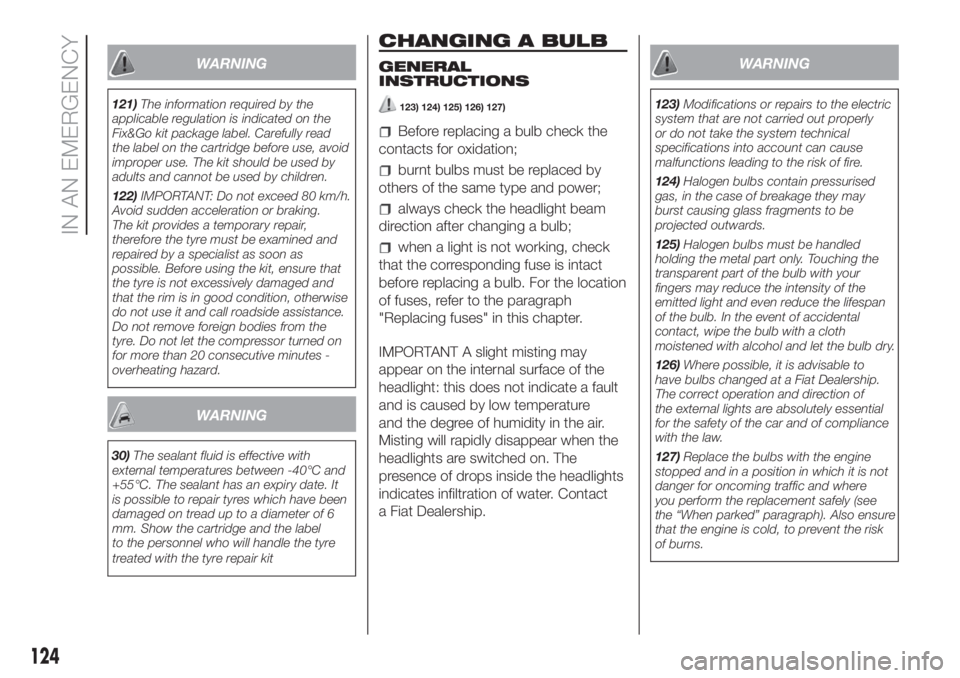
WARNING
121)The information required by the
applicable regulation is indicated on the
Fix&Go kit package label. Carefully read
the label on the cartridge before use, avoid
improper use. The kit should be used by
adults and cannot be used by children.
122)IMPORTANT: Do not exceed 80 km/h.
Avoid sudden acceleration or braking.
The kit provides a temporary repair,
therefore the tyre must be examined and
repaired by a specialist as soon as
possible. Before using the kit, ensure that
the tyre is not excessively damaged and
that the rim is in good condition, otherwise
do not use it and call roadside assistance.
Do not remove foreign bodies from the
tyre. Do not let the compressor turned on
for more than 20 consecutive minutes -
overheating hazard.
WARNING
30)The sealant fluid is effective with
external temperatures between -40°C and
+55°C. The sealant has an expiry date. It
is possible to repair tyres which have been
damaged on tread up to a diameter of 6
mm. Show the cartridge and the label
to the personnel who will handle the tyre
treated with the tyre repair kit
CHANGING A BULB
GENERAL
INSTRUCTIONS
123) 124) 125) 126) 127)
Before replacing a bulb check the
contacts for oxidation;
burnt bulbs must be replaced by
others of the same type and power;
always check the headlight beam
direction after changing a bulb;
when a light is not working, check
that the corresponding fuse is intact
before replacing a bulb. For the location
of fuses, refer to the paragraph
"Replacing fuses" in this chapter.
IMPORTANT A slight misting may
appear on the internal surface of the
headlight: this does not indicate a fault
and is caused by low temperature
and the degree of humidity in the air.
Misting will rapidly disappear when the
headlights are switched on. The
presence of drops inside the headlights
indicates infiltration of water. Contact
a Fiat Dealership.
WARNING
123)Modifications or repairs to the electric
system that are not carried out properly
or do not take the system technical
specifications into account can cause
malfunctions leading to the risk of fire.
124)Halogen bulbs contain pressurised
gas, in the case of breakage they may
burst causing glass fragments to be
projected outwards.
125)Halogen bulbs must be handled
holding the metal part only. Touching the
transparent part of the bulb with your
fingers may reduce the intensity of the
emitted light and even reduce the lifespan
of the bulb. In the event of accidental
contact, wipe the bulb with a cloth
moistened with alcohol and let the bulb dry.
126)Where possible, it is advisable to
have bulbs changed at a Fiat Dealership.
The correct operation and direction of
the external lights are absolutely essential
for the safety of the car and of compliance
with the law.
127)Replace the bulbs with the engine
stopped and in a position in which it is not
danger for oncoming traffic and where
you perform the replacement safely (see
the “When parked” paragraph). Also ensure
that the engine is cold, to prevent the risk
of burns.
124
IN AN EMERGENCY
Page 153 of 220
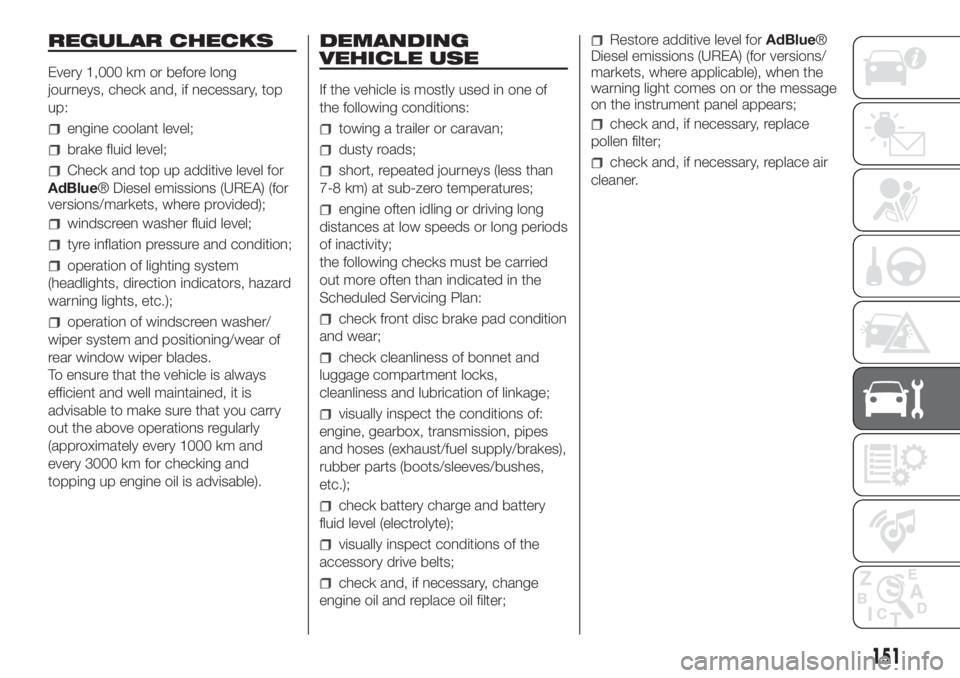
REGULAR CHECKS
Every 1,000 km or before long
journeys, check and, if necessary, top
up:
engine coolant level;
brake fluid level;
Check and top up additive level for
AdBlue® Diesel emissions (UREA) (for
versions/markets, where provided);
windscreen washer fluid level;
tyre inflation pressure and condition;
operation of lighting system
(headlights, direction indicators, hazard
warning lights, etc.);
operation of windscreen washer/
wiper system and positioning/wear of
rear window wiper blades.
To ensure that the vehicle is always
efficient and well maintained, it is
advisable to make sure that you carry
out the above operations regularly
(approximately every 1000 km and
every 3000 km for checking and
topping up engine oil is advisable).
DEMANDING
VEHICLE USE
If the vehicle is mostly used in one of
the following conditions:
towing a trailer or caravan;
dusty roads;
short, repeated journeys (less than
7-8 km) at sub-zero temperatures;
engine often idling or driving long
distances at low speeds or long periods
of inactivity;
the following checks must be carried
out more often than indicated in the
Scheduled Servicing Plan:
check front disc brake pad condition
and wear;
check cleanliness of bonnet and
luggage compartment locks,
cleanliness and lubrication of linkage;
visually inspect the conditions of:
engine, gearbox, transmission, pipes
and hoses (exhaust/fuel supply/brakes),
rubber parts (boots/sleeves/bushes,
etc.);
check battery charge and battery
fluid level (electrolyte);
visually inspect conditions of the
accessory drive belts;
check and, if necessary, change
engine oil and replace oil filter;
Restore additive level forAdBlue®
Diesel emissions (UREA) (for versions/
markets, where applicable), when the
warning light comes on or the message
on the instrument panel appears;
check and, if necessary, replace
pollen filter;
check and, if necessary, replace air
cleaner.
151
Page 158 of 220
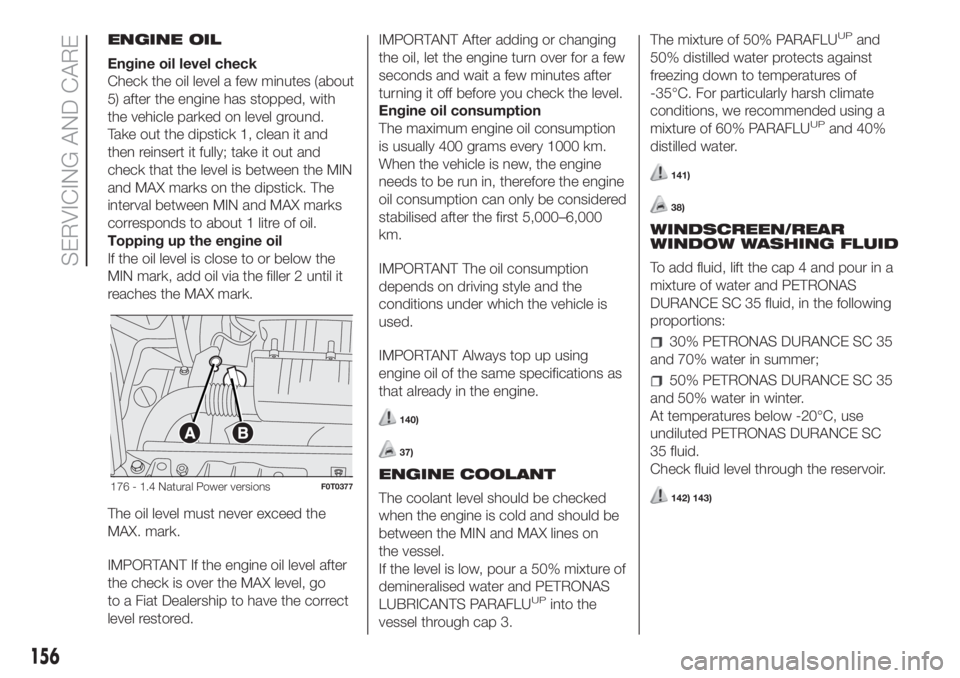
ENGINE OIL
Engine oil level check
Check the oil level a few minutes (about
5) after the engine has stopped, with
the vehicle parked on level ground.
Take out the dipstick 1, clean it and
then reinsert it fully; take it out and
check that the level is between the MIN
and MAX marks on the dipstick. The
interval between MIN and MAX marks
corresponds to about 1 litre of oil.
Topping up the engine oil
If the oil level is close to or below the
MIN mark, add oil via the filler 2 until it
reaches the MAX mark.
The oil level must never exceed the
MAX. mark.
IMPORTANT If the engine oil level after
the check is over the MAX level, go
to a Fiat Dealership to have the correct
level restored.IMPORTANT After adding or changing
the oil, let the engine turn over for a few
seconds and wait a few minutes after
turning it off before you check the level.
Engine oil consumption
The maximum engine oil consumption
is usually 400 grams every 1000 km.
When the vehicle is new, the engine
needs to be run in, therefore the engine
oil consumption can only be considered
stabilised after the first 5,000–6,000
km.
IMPORTANT The oil consumption
depends on driving style and the
conditions under which the vehicle is
used.
IMPORTANT Always top up using
engine oil of the same specifications as
that already in the engine.
140)
37)
ENGINE COOLANT
The coolant level should be checked
when the engine is cold and should be
between the MIN and MAX lines on
the vessel.
If the level is low, pour a 50% mixture of
demineralised water and PETRONAS
LUBRICANTS PARAFLU
UPinto the
vessel through cap 3.The mixture of 50% PARAFLU
UPand
50% distilled water protects against
freezing down to temperatures of
-35°C. For particularly harsh climate
conditions, we recommended using a
mixture of 60% PARAFLU
UPand 40%
distilled water.
141)
38)
WINDSCREEN/REAR
WINDOW WASHING FLUID
To add fluid, lift the cap 4 and pour in a
mixture of water and PETRONAS
DURANCE SC 35 fluid, in the following
proportions:
30% PETRONAS DURANCE SC 35
and 70% water in summer;
50% PETRONAS DURANCE SC 35
and 50% water in winter.
At temperatures below -20°C, use
undiluted PETRONAS DURANCE SC
35 fluid.
Check fluid level through the reservoir.
142) 143)176 - 1.4 Natural Power versionsF0T0377
156
SERVICING AND CARE